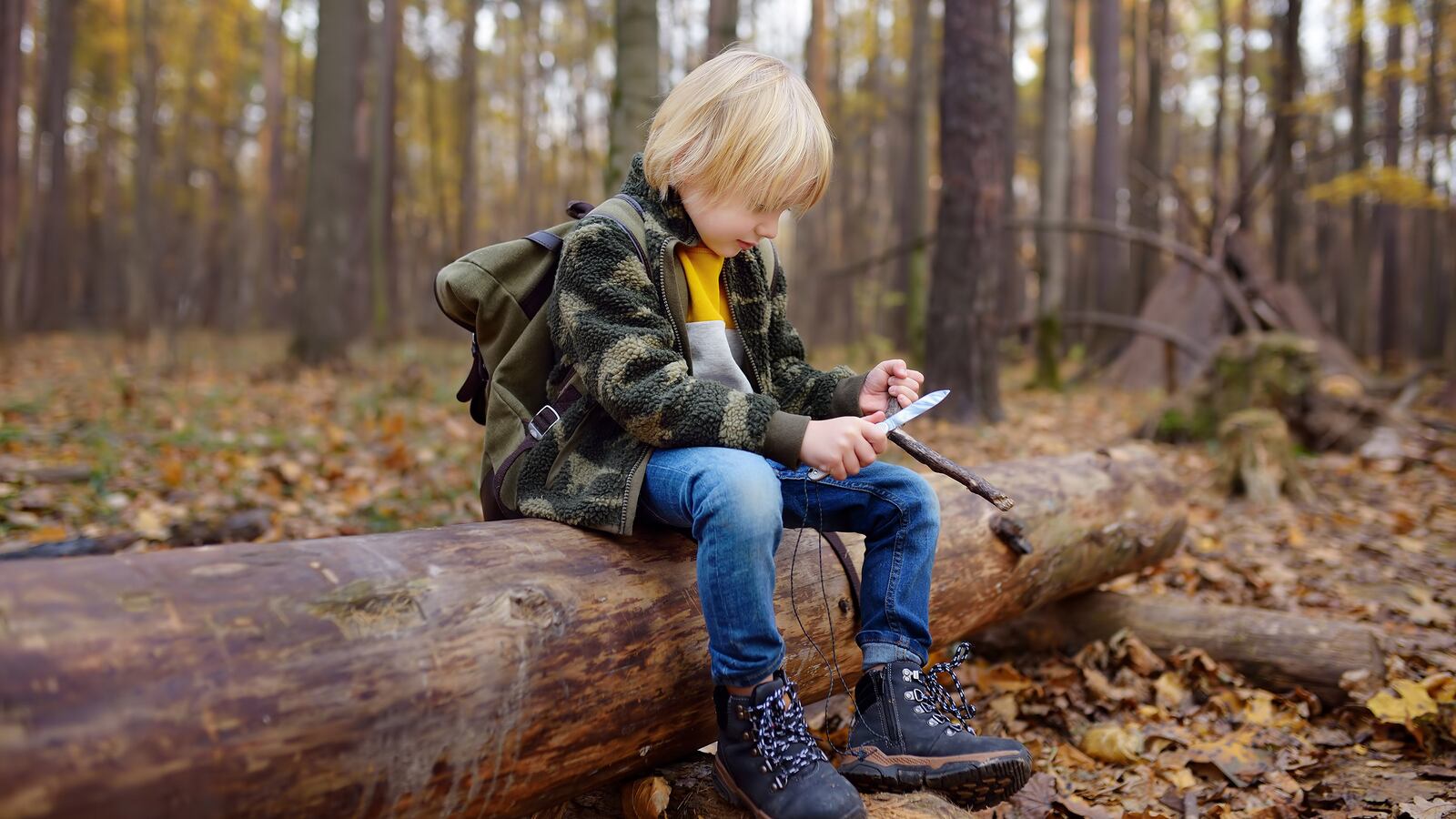There was a stark reality I faced when I first became a father: I’m not able to be with my kids at all times to protect them and keep them safe. Because of this reality, I want to know that I’ve done everything possible to prepare them and teach them so that they have the best chance to avoid danger, survive dangerous scenarios, defend themselves if necessary, and make it back home. As part of this endeavor, I began teaching my kids how to use pocketknives properly when they each turned 5 years old.
I first introduced them to basic pocketknives for kids—“my first Opinel knife” and “my first Victorinox Swiss Army knife,” neither of which has a sharp point, just rounded tips like a butter knife. I taught them how to whittle wood with these knives. Whittling is something most kids love or learn to love if given the opportunity within a safe environment, and if they understand the rules of using a pocketknife.
At first, I started with long thin sticks for roasting marshmallows and hot dogs over the campfire. There’s a certain joy that comes from carving your first of many marshmallow and hot dog sticks.
“You made this stick,” I would tell the kids. “You carved the point and made something from your own hands. You accomplished something—doesn’t that feel good?” I’d ask them as they pushed the marshmallow or hot dog onto the stick to roast it over the fire. This has become a rite of passage.
In the time that followed, I taught them to carve larger spears and walking sticks. They even carved small utensils and tools out of wood. They also learned how to open boxes and packages properly, cut rope, and do other things that require a knife or something sharp.
Additionally, I’d like to point out, these early pocketknives were always kept somewhere safe and out of reach. They were brought out only under adult supervision, and the rules were always reinforced, i.e., always cut away from your body, a dull knife is a dangerous knife, etc.).
Occasionally, and inevitably, accidents happened, and the kids would make minor cuts on their hands. Even Dad, who is extremely experienced, sometimes cut himself by accident, and this is where proper Band-Aid and first aid procedures came in. This is also why it’s so important that your kids understand the uses and power of knives and cutting and have some basic familiarity, so that they keep themselves safe. For example, if they’re at a friend’s house, and the friend starts to play with a knife, their familiarity with knives can actually keep them safe. On the contrary, if they’ve never held a pocketknife or been taught the rules, this leaves them unprepared, vulnerable, and potentially in a dangerous situation if they find themselves alone or without parental supervision.
As my kids grew older, I carefully and strategically introduced them to more complicated and sophisticated knives, as well as the concept that in addition to using a knife as a tool or for survival, it could also be used for self-defense in extreme situations. While at The Farm, the CIA’s covert training facility, I learned the importance of leveling the playing field, and you can do that by carrying a knife.
As parents, we of course hope that our kids would never be put in a situation where the need to defend themselves would ever arise. But the reality is that kids are kidnapped and go missing every day, and some kids unfortunately find themselves in dangerous scenarios that they are unable to avoid. I would rather my kids have a knife with them and not need it, than need one and not have it.
As a result, I’ve drifted towards the karambit neck knife, which has a curved blade (the most efficient form in nature, like a tiger’s claw) and often a hole to stick your finger through in the grip. It’s extremely difficult for someone to take it from you, and if they try, the tip of the blade could still reach the attacker’s hand or arm and even inflict damage while they’re trying to wrestle the knife away from you.
The benefit of carrying a karambit is that it gives someone extra confidence and peace of mind, and it really is a deterrent. To put it frankly, the karambit looks scary and badass. If you ever had to whip it out (hopefully that’s something that would never happen), just the sight of it in your hand would likely make someone walk away. You don’t mess with a karambit. In addition, because it’s a neck knife, no one knows it’s there. Someone could take your purse or your bag, or make you empty your pockets, or throw you in the back of a van, but your neck knife is still hidden on your person and ready for when you need it.
The use of pocketknives with my kids eventually turned to the use of wooden swords. Wooden swords are the precursors to machetes and actual swords. I love adventure books and movies, and what adventure doesn’t have a machete or sword? Take Indiana Jones, for example, what did he carry while hiking through the jungle? A machete. On the television show Naked and Afraid, where people are often allowed to bring one tool with them, they often choose the machete. There are so many uses for the machete, from cutting down bushes and trees to building a shelter to learning how to defend yourself, i.e., a machete is basically a small sword.
If there were an apocalypse or end of the world scenario that lasted months or years, guns would at some point become useless, unless you had stockpiled ammunition. A machete or a sword would likely (again) become the tool of choice. All you need to do is keep them sharp. In fact, historically, a sword was the one tool that was in many homes for thousands of years. The “Grosse Messer” sword by Cold Steel is a perfect example of this.
Wooden swords, plastic light sabers, and legitimate practice swords made of polypropylene are all great for practicing with kids, and in fact, a lot of kids have this natural desire and curiosity. Most people, however, don’t know how to use a sword, or how to use it properly. I actually tried to find a legitimate professional training studio that did this. The best I could find was a studio in Seattle where my kids trained and learned the art of “fencing” which was great for them to understand some basics and fundamentals. At the end of the day though, this studio could only teach them so much.
Fast forward to today, and you’ll find my older kids and me sword fighting each other with our practice swords, practicing techniques, offensive and defensive, and learning how we would protect ourselves in a real situation, if we ever needed to. More than anything, this is a fun bonding experience and exercise. It feels more like a game than any type of training session or lesson, and as a result, they continue to learn and perfect their skills. Nothing makes me prouder than seeing the kids get better at something than I am, and I’m finding this happens more and more as I watch my oldest son get stronger and quicker with his sword. He’s even started to beat me in most of our sessions.
Another tool I taught the kids from an early age was how to use the longbow for archery. I began training my two oldest kids in Switzerland when they were 3 and 5 years old. They began with simple, small beginner’s bows and arrows and a large target. Over the years, they’ve worked on perfecting their skills. Using instinct (rather than aim) to shoot their arrows exactly where they wanted them, whether they or their targets were stationary or moving. They regularly played archery games at their grandparents’ house, where they took advantage of their several acres of land.
My oldest daughter, Hannah, became increasingly enthralled with archery, especially after reading and watching the Hunger Games series; she wanted to be like Katniss and was an extremely accurate shot. My youngest daughter at the time, Lena, wanted to be like Merida from Disney’s Brave, and Hunter, well, he was a natural right off the bat. The girls still love archery but have drifted away from it as teenagers.
Hunter, on the other hand, eventually moved up from a longbow to a compound bow. For his fifteenth birthday, I bought him a Mathews compound bow. We now regularly shoot our compound bows together, and in addition to improving his archery skills, which can be used in a survival context and/or for hunting, it’s a great way to spend quality time with each other.
At the end of the day, it’s about ensuring I’ve done everything I can to teach the kids to defend themselves, if necessary, and ultimately survive. When done appropriately and safely, this can be a great way to prepare your kids for dangerous situations when you can’t be there to protect them.

Ryan Hillsberg is the co-author, with Christina Hillsberg, of LICENSE TO PARENT: How My Career As a Spy Helped Me Raise Resourceful, Self-Sufficient Kids. Both are former CIA intelligence officers who later transitioned to the private sector. They live near Seattle, Washington, with their five children and two Rhodesian Ridgebacks.







